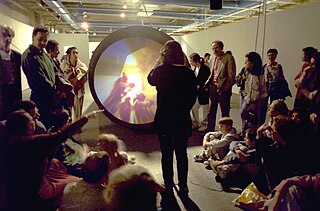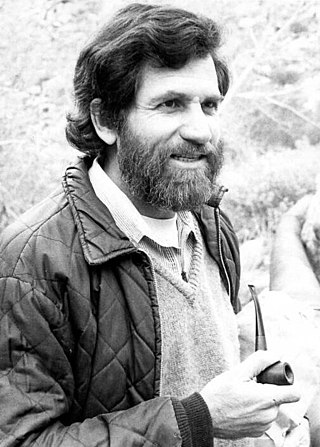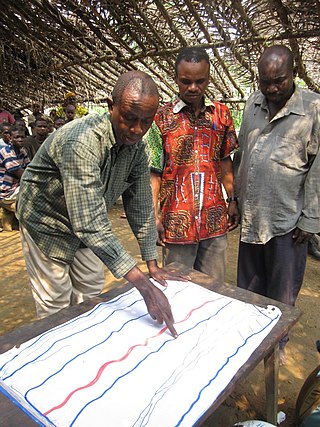Related Research Articles
A happening is a performance, event, or situation art, usually as performance art. The term was first used by Allan Kaprow during the 1950s to describe a range of art-related events.

Installation art is an artistic genre of three-dimensional works that are often site-specific and designed to transform the perception of a space. Generally, the term is applied to interior spaces, whereas exterior interventions are often called public art, land art or art intervention; however, the boundaries between these terms overlap.

Interactive art is a form of art that involves the spectator in a way that allows the art to achieve its purpose. Some interactive art installations achieve this by letting the observer walk through, over or around them; others ask the artist or the spectators to become part of the artwork in some way.

Performance art is an artwork or art exhibition created through actions executed by the artist or other participants. It may be witnessed live or through documentation, spontaneously developed or written, and is traditionally presented to a public in a fine art context in an interdisciplinary mode. Also known as artistic action, it has been developed through the years as a genre of its own in which art is presented live. It had an important and fundamental role in 20th century avant-garde art.

Postmodern art is a body of art movements that sought to contradict some aspects of modernism or some aspects that emerged or developed in its aftermath. In general, movements such as intermedia, installation art, conceptual art and multimedia, particularly involving video are described as postmodern.
Alternative media are media sources that differ from established or dominant types of media in terms of their content, production, or distribution. Sometimes the term independent media is used as a synonym, indicating independence from large media corporations, but this term is also used to indicate media enjoying freedom of the press and independence from government control. Alternative media does not refer to a specific format and may be inclusive of print, audio, film/video, online/digital and street art, among others. Some examples include the counter-culture zines of the 1960s, ethnic and indigenous media such as the First People's television network in Canada, and more recently online open publishing journalism sites such as Indymedia.

Protest art is the creative works produced by activists and social movements. It is a traditional means of communication, utilized by a cross section of collectives and the state to inform and persuade citizens. Protest art helps arouse base emotions in their audiences, and in return may increase the climate of tension and create new opportunities to dissent. Since art, unlike other forms of dissent, take few financial resources, less financially able groups and parties can rely more on performance art and street art as an affordable tactic.

Allan Kaprow was an American painter, assemblagist and a pioneer in establishing the concepts of performance art. He helped to develop the "Environment" and "Happening" in the late 1950s and 1960s, as well as their theory. His Happenings — some 200 of them — evolved over the years. Eventually Kaprow shifted his practice into what he called "Activities", intimately scaled pieces for one or several players, devoted to the study of normal human activity in a way congruent to ordinary life. Fluxus, performance art, and installation art were, in turn, influenced by his work.

Alison Knowles is an American visual artist known for her installations, performances, soundworks, and publications. Knowles was a founding member of the Fluxus movement, an international network of artists who aspired to merge different artistic media and disciplines. Criteria that have come to distinguish her work as an artist are the arena of performance, the indeterminacy of her event scores resulting in the deauthorization of the work, and the element of tactile participation. She graduated from Pratt Institute in New York with an honors degree in fine art. In May 2015, she was awarded an honorary doctorate degree by Pratt.
Theatre for development (TfD) is a type of community-based or interactive theatre practice that aims to promote civic dialogue and engagement.
Community art, also known as social art, community-engaged art, community-based art, and, rarely, dialogical art, is the practice of art based in and generated in a community setting. It is closely related to social practice and social turn. Works in this form can be of any media and are characterized by interaction or dialogue with the community. Professional artists may collaborate with communities which may not normally engage in the arts. The term was defined in the late 1960s as the practice grew in the United States, Canada, the Netherlands, the United Kingdom, Ireland, and Australia. In Scandinavia, the term "community art" more often refers to contemporary art projects.
Social practice is a theory within psychology that seeks to determine the link between practice and context within social situations. Emphasized as a commitment to change, social practice occurs in two forms: activity and inquiry. Most often applied within the context of human development, social practice involves knowledge production and the theorization and analysis of both institutional and intervention practices.
Participatory media is communication media where the audience can play an active role in the process of collecting, reporting, analyzing and disseminating content. Citizen / Participatory Journalism, Citizen Media, Empowerment Journalism and Democratic Media are related principles.
Relational art or relational aesthetics is a mode or tendency in fine art practice originally observed and highlighted by French art critic Nicolas Bourriaud. Bourriaud defined the approach as "a set of artistic practices which take as their theoretical and practical point of departure the whole of human relations and their social context, rather than an independent and private space." The artist can be more accurately viewed as the "catalyst" in relational art, rather than being at the centre.
Participatory culture, an opposing concept to consumer culture, is a culture in which private individuals do not act as consumers only, but also as contributors or producers (prosumers). The term is most often applied to the production or creation of some type of published media.

Participatory planning is an urban planning paradigm that emphasizes involving the entire community in the community planning process. Participatory planning emerged in response to the centralized and rationalistic approaches that defined early urban planning work. It has become a highly influential paradigm both in the context of traditional urban planning, and in the context of international community development. There is no singular theoretical framework or set of practical methods that make up participatory planning. Rather, it is a broad paradigm which incorporates a wide range of diverse theories and approaches to community planning. In general, participatory planning programs prioritize the integration of technical expertise with the preferences and knowledge of community members in the planning process. They also generally emphasize consensus building and collective community decision making, and prioritize the participation of traditionally marginalized groups in the planning process.
Telematic art is a descriptive of art projects using computer-mediated telecommunications networks as their medium. Telematic art challenges the traditional relationship between active viewing subjects and passive art objects by creating interactive, behavioural contexts for remote aesthetic encounters. Telematics was first coined by Simon Nora and Alain Minc in The Computerization of Society. Roy Ascott sees the telematic art form as the transformation of the viewer into an active participator of creating the artwork which remains in process throughout its duration. Ascott has been at the forefront of the theory and practice of telematic art since 1978 when he went online for the first time, organizing different collaborative online projects.
Paul Ramírez Jonas is an American artist and arts educator, who is known for his social practice artworks exploring the potential between artist, audience, artwork and public. Many of Ramirez Jonas's projects use pre-existing texts, models, or materials to reenact or prompt actions.
Social practice or socially engaged practice is an art medium that focuses on engagement through human interaction and social discourse. Social practice goes by many names, including relational aesthetics, new genre public art, socially engaged art, dialogical art, and participatory art. Social practice work focuses on the interaction between the audience, social systems, and the artist or artwork through aesthetics, ethics, collaboration, methodology, antagonism, media strategies, and/or social activism.
Immersive theater differentiates itself from traditional theater by removing the stage and immersing audiences within the performance itself. Often, this is accomplished by using a specific location (site-specific), allowing audiences to converse with the actors and interact with their surroundings (interactive), thereby breaking the fourth wall.
References
- ↑ Richard Ross."At Large In Santa Barbara." LAICA Journal. September–October 1980, Number 28. 45-47
- ↑ Mount, Andrew (2010). "Participation, Hosting And Mimesis: The Double Being".
- ↑ Graham, Beryl. "What kind of participative system? Critical Vocabularies from new media art". The 'do-it-yourself' Artwork: Participation from Fluxus to New Media: 290.
- ↑ Nettl, Bruno, Music in Primitive Culture, Cambridge, Harvard 1956, p. 10.